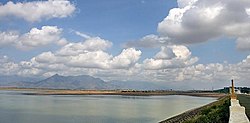| Vaigai River | |
|---|---|
 | |
 Map of Vaigai river | |
| Etymology | … |
| Location | |
| Country | India |
| . | |
| Physical characteristics | |
| Source | Varusanadu Hills |
| • location | Tamil Nadu, India |
| Mouth | |
• location | Palk Bay, India |
• elevation | 0 m (0 ft) |
| Length | 258 km (160 mi) |
| Discharge | |
| • average | 36 m3/s (1,300 cu ft/s) |
| Discharge | |
| • location | Peranai[1] |
| • average | 28.8 m3/s (1,020 cu ft/s) |
Vaigai River | ||||||||||||||||||||||||||||||||||||||||||||||||||||||||||||||||||||||||||||||||||||||||||||||||||||||||||||||||||||||||||||||||||||||||||||||||||||||||||||||||||||||||||||||||||||||||||||||||||||||||||||||||||||||||||||||||
|---|---|---|---|---|---|---|---|---|---|---|---|---|---|---|---|---|---|---|---|---|---|---|---|---|---|---|---|---|---|---|---|---|---|---|---|---|---|---|---|---|---|---|---|---|---|---|---|---|---|---|---|---|---|---|---|---|---|---|---|---|---|---|---|---|---|---|---|---|---|---|---|---|---|---|---|---|---|---|---|---|---|---|---|---|---|---|---|---|---|---|---|---|---|---|---|---|---|---|---|---|---|---|---|---|---|---|---|---|---|---|---|---|---|---|---|---|---|---|---|---|---|---|---|---|---|---|---|---|---|---|---|---|---|---|---|---|---|---|---|---|---|---|---|---|---|---|---|---|---|---|---|---|---|---|---|---|---|---|---|---|---|---|---|---|---|---|---|---|---|---|---|---|---|---|---|---|---|---|---|---|---|---|---|---|---|---|---|---|---|---|---|---|---|---|---|---|---|---|---|---|---|---|---|---|---|---|---|---|---|---|---|---|---|---|---|---|---|---|---|---|---|---|---|---|
| ||||||||||||||||||||||||||||||||||||||||||||||||||||||||||||||||||||||||||||||||||||||||||||||||||||||||||||||||||||||||||||||||||||||||||||||||||||||||||||||||||||||||||||||||||||||||||||||||||||||||||||||||||||||||||||||||
The Vaigai is a river in the Tamil Nadu state of southern India; it passes through the towns of Theni, Madurai and Ramanathapuram.[2] It originates in Varusanadu Hills, the Periyar Plateau of the Western Ghats range, and flows northeast through the Kambam Valley, which lies between the Palani Hills to the north and the Varushanad Hills to the south. The Vattaparai Falls are located on this river. As it rounds the eastern corner of the Varushanad Hills, the river turns southeast, running through the region of Pandya Nadu. Madurai, the largest city in the Pandya Nadu region and its ancient capital, lies on the Vaigai. The river empties into the Palk Bay near Alagankulam, close to Pamban Bridge in Ramanathapuram District.
The Vaigai is 258 kilometres (160 mi) long, with a drainage basin 7,031 square kilometres (2,715 sq mi) large.[3] This river flows through 5 districts namely Theni, Dindigul, Madurai, Sivagangai and Ramanathapuram and this river Serves as a Lifeline for 6 districts namely Theni, Dindigul, Madurai, Sivagangai, Virudhunagar and Ramanathapuram as farmers of all these districts are greatly depends on this river water.
- ^ "Gauging Station – Data Summary". ORNL. Retrieved 1 October 2013.
- ^ Madurai, Temple Town of South India. Cultural capital of Tamilnadu
- ^ Garg, Santosh Kumar (1999). International and interstate river water disputes. Laxmi Publications. p. 10. ISBN 978-81-7008-068-8. Retrieved 16 May 2011.